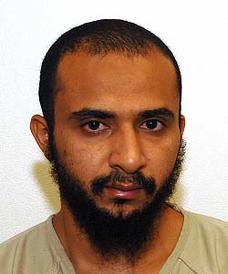Progress Towards Closing Guantánamo, As Periodic Review Boards Resume

Tariq al-Sawah, an Egyptian prisoner at Guantánamo, who is morbidly obese and has other serious health problems, and who faced a Periodic Review Board on January 22, 2015, to ascertain whether he should still be held.
By Andy Worthington, January 23, 2015
The last three months have been a period of commendable progress at Guantánamo, as 27 prisoners have been released, reducing the prison's population to just 122 men. On December 30, two Tunisians and three Yemenis were given new homes in Kazakhstan, and on January 14 five more Yemenis were given new homes -- four in Oman, in the Gulf, and one in Estonia. All of these men had long been approved for release, having had their cases reviewed in 2009 by the high-level, inter-agency Guantánamo Review Task Force, which issued its final report in January 2010.
Obstacles raised by Congress -- and the president's unwillingness to spend political capital overcoming those obstacles -- had led to these men being held for so long after the task force unanimously approved them for release, as well as a particular fear throughout the U.S. establishment of repatriating Yemenis, because of unrest in their home country.
Two years ago, 86 of the men still held had been approved for release by the task force but were still held. That number is now down to 50, of whom 43 are Yemenis, and just seven are from other nations, including Shaker Aamer, the last British resident in the prison.
Four more men have had their releases approved in the last year by Periodic Review Boards, another high-level, inter-agency process established in 2013 to review the cases of the majority of the men not cleared for release, to establish whether or not they are still regarding as constituting a threat.
Of the 68 men not approved for release, only ten are facing -- or have faced -- military commission trials at Guantánamo. Of the 58 others, 23 were recommended for prosecution by the task force, until the appeals court in Washington D.C. began dismissing the handful of convictions secured in the military commissions' contentious history, on the basis that they were for war crimes that were not recognized internationally, and had been invented by Congress.
35 others were recommended for ongoing imprisonment without charge or trial, on the basis that they were regarded as "too dangerous to release," but insufficient evidence existed to put them on trial. This latter category ought to trouble anyone with respect for the law, because if there isn't enough evidence to put someone on trial, then it's not evidence -- and in the case of the Guantánamo prisoners, this is because prisoners were routinely subjected to torture or other forms of abuse, or were bribed with the promise of comfort items, or because they simply grew exhausted by the pointless non-stop questioning, and began to tell their interrogators whatever they wanted to hear. The information obtained from the prisoners is, to be blunt, worthless to a shocking degree.
Here at "Close Guantánamo," we are heartened to hear that the Periodic Reviews have resumed, after the nine prisoner reviews last year, which resulted in six of the men being recommended for release, and two being freed. The other four are Yemenis, who join their compatriots in the queue of Yemenis awaiting release. The last Yemeni to be cleared, Abdel Malik Ahmed Abdel Wahab Al-Rahabi (ISN 037), was recommended for ongoing detention in March 2014 after his PRB, but was approved for release in November after a second PRB.
The first review of the year took place on January 22, and was the first for any of the 23 prisoners who had initially been recommended for prosecution, but had been downgraded after the near-total collapse in the legitimacy of the military commissions.
The story of Tariq al-Sawah
The prisoner in question, Tariq Mahmoud Ahmed al-Sawah (ISN 535), is known to seasoned Guantánamo watchers. An explosives expert in Afghanistan -- possibly with al-Qaeda connections, although he has always denied it -- he became disillusioned with his former life and has cooperated extensively with the authorities in Guantánamo. He is also seriously ill.
As the Associated Press described it in October 2013, he is "in terrible shape after 11 [now nearly 13] years as a prisoner at Guantánamo Bay, a fact even the U.S. military does not dispute." At the time he was 55 years old, and his weight "has nearly doubled" during his long imprisonment, "reaching more than 420 pounds at one point, and his health has deteriorated as a result, both his lawyers and government officials concede."
His lawyers -- and a doctor who has examined him -- paint what the AP described as "a dire picture" of "a morbidly obese man with diabetes and a range of other serious ailments," who "is short of breath, barely able to walk 10 feet, unable to stay awake in meetings and faces the possibility of not making it out of prison alive."
As I also explained in that article, the AP noted that al-Sawah had high-level support for his release, having "received letters of recommendation from three former Guantánamo commanders." One, Rear Adm. David Thomas, recommended his release in his classified military file (his Detainee Assessment Brief) in September 2008, which was released by WikiLeaks in 2011, and only later contradicted by President Obama's task force. In that file, al-Sawah's health issues were also prominent. It was noted that he was "closely watched for significant and chronic problems" that included high cholesterol, diabetes and liver disease.
There was also a letter from an unnamed official who spent several hours a week with al-Sawah over the course of 18 months, who noted that he had been "friendly and cooperative" with US personnel, and stated, "Frankly, I felt Tarek [Tariq] was a good man on the other side who, in a different world, different time, different place, could easily be accepted as a friend or neighbour."
Just as important is the fact that, back in March 2010, in an important article for the Washington Post, Peter Finn reported that al-Sawah and another prisoner, Mohamedou Ould Slahi, a Mauritanian whose heart-rending memoir, written in Guantánamo, has just been published as a book, even though he is still held in the prison, "had become two of the most significant informants" in Guantánamo. As a result, they were "housed in a little fenced-in compound at the military prison, where they live[d] a life of relative privilege -- gardening, writing and painting -- separated from other detainees in a cocoon designed to reward and protect."
What was particularly shocking about this was the refusal of the authorities to reward the men for their extensive cooperation by releasing them. As Finn noted, "Some military officials believe the United States should let them go -- and put them into a witness protection program, in conjunction with allies, in a bid to cultivate more informants," an eminently sensible suggestion that was endorsed by W. Patrick Lang, a retired senior military intelligence officer. "I don’t see why they aren’t given asylum," Lang said. "If we don’t do this right, it will be that much harder to get other people to cooperate with us. And if I was still in the business, I’d want it known we protected them. It’s good advertising." Finn also noted that a military official at Guantánamo at the time of his article had "suggested that that argument was fair," although he stated that it was "a hard-sell argument around here."
It is to be hoped that his release will not be such a hard-sell now. His detainee profile, for his PRB, stated that he "met numerous senior terrorist leaders, but there are no indications he held a leadership position," adding that while he "openly admits to having taken part in terrorism, there are no indications that he is interested in reengaging in extremist activity. He has told interrogators that he hopes to reunite with family members-some of whom live in Egypt, Bosnia, and the U.S." Those drafting the profile added that there were "no indications that [al-Sawah] is in communication with extremists outside of Guantánamo," and also explained that, if he "were repatriated to Egypt, he probably would seek to reside temporarily with family members while pursuing opportunities to resettle elsewhere," which may be optimistic given his previous history, and it may be that, if approved for release, he will need to be resettled in a third country.
We will be watching the progress of the PRBs closely, hoping that President Obama can release all the prisoners approved for release, and that the review boards will also approve the release many of those who come before them, and who, we are willing to demonstrate through an analysis of the so-called evidence, are not, and have never been "too dangerous to release."
Note: Five more PRBs are forthcoming. Saeed Ahmed Mohammed Abdullah Sarem Jarabh (ISN 235), a Yemeni, has his hearing on January 27, and Khalid Ahmed Qasim (ISN 242), another Yemeni, follows on February 4. The three others were notified of their forthcoming PRBs on January 13. They are Mashur Abdullah Muqbil Ahmed Al-Sabri (ISN 324), a Yemeni, Abdul Shalabi (ISN 042), another Yemeni (and a long-term hunger striker), and Omar Khalif Mohammed Abu Baker Mahjour Umar (ISN 695), aka Omar Mohammed Khalifh, a Libyan whose habeas corpus petition was turned down in 2010.
Postscript January 28

Saeed Jarabh, in a photo included in the classified military files released by WikiLeaks in 2011.
On January 27, the second PRB of the year took place -- for Saeed Ahmed Mohammed Abdullah Sarem Jarabh (ISN 235), a Yemeni who is 36 years old, and has been held since he was 23. The military representatives assigned to represent him stated that he "desires to return home to Yemen and reunite with his wife, his aging parents, and especially with his 2 daughters," adding, poignantly, "His oldest daughter is engaged to be married in the next two years and Saeed dreams of being there on this special day for his daughter."
They also stated, "While detained at Guantánamo, Saeed has maximized every opportunity available to him for personal growth and education … [H]e has pursued the study of English and Spanish languages, both spoken and written. This effort will greatly benefit him should he be transferred to a country other than Yemen. Additionally, Saeed has studied to increase his business acumen. Notably, he led a detainee project which developed a formal business plan for an agrarian farming operation. These skills are in high demand and are transferrable to any environment Saeed should find himself in." The representatives also noted, "Saeed has engaged in constructive hobbies in order to keep his mind active and healthy while detained. His pursuit of the art of painting preserved both his sense of hope and love of life."
In its detainee profile, the military claimed that he had "possibly" fought for the Taliban in Afghanistan, but conceded that he "has provided no information of intelligence value since his initial debriefings at Guantánamo." In addition, the military noted that there are "no indications he harbors strong anti-American sentiments relative to other Guantánamo detainees, extremist beliefs, or intentions to reengage."




